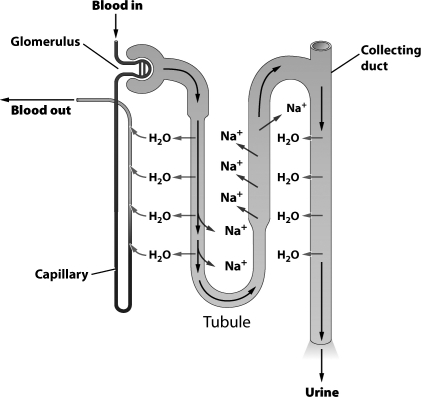A) act as barriers to excessive movement of materials to and from blood plasma.
B) are selectively permeable, allowing only one-way movement of materials from interstitial fluid to blood plasma.
C) are thin-walled, allowing diffusion of materials to and from blood plasma and interstitial fluid.
D) actively transport materials from blood plasma to interstitial fluid.
Correct Answer

verified
Correct Answer
verified
True/False
Despite its large size, an elephant can conserve heat energy longer than a hummingbird.
Correct Answer

verified
Correct Answer
verified
Short Answer
The lack of water, otherwise known as ____________________, can lead to heatstroke.
Correct Answer

verified
Correct Answer
verified
Multiple Choice
The circulation of blood through the body eventually increases the rate of heat transfers by
A) evaporation.
B) conduction.
C) convection.
D) radiation.
Correct Answer

verified
Correct Answer
verified
Short Answer
Animals can gain or lose heat by conduction and radiation, but the process of ____________________ only results in heat loss.
Correct Answer

verified
Correct Answer
verified
Multiple Choice
The physical movement of heat that results from the movement of air or water is known as
A) convection.
B) conduction.
C) evaporation.
D) radiation.
Correct Answer

verified
Correct Answer
verified
Multiple Choice
For a vertebrate animal to obtain and use energy,
A) the digestive system is used to break down oxygen to be stored in cells.
B) the circulatory system must provide carbon dioxide to cells.
C) the circulatory, respiratory, digestive, endocrine, and nervous systems are some systems involved.
D) only one organ system, the digestive system, is needed.
Correct Answer

verified
Correct Answer
verified
Short Answer
____________________ tissue, the interface between an organism and its environment, regulates the amount of water, heat, and other substances that are exchanged with the external environment.
Correct Answer

verified
Correct Answer
verified
Short Answer
An animal can lose heat by ____________________ even when the environmental temperature is greater than its internal temperature.
Correct Answer

verified
Correct Answer
verified
Multiple Choice
A breeze cools a hot, dry surface by
A) conduction.
B) convection.
C) radiation.
D) evaporation.
Correct Answer

verified
Correct Answer
verified
Multiple Choice
In our kidneys, blood gets filtered in
A) the glomerulus.
B) the tubules.
C) capillaries surrounding the tubules.
D) the bladder.
Correct Answer

verified
Correct Answer
verified
Multiple Choice
Why do animals that live in cold climates have thick fur coats?
A) Fur reduces convection and traps a layer of air heated by conduction close to the skin, keeping the animal's body warmer.
B) Thicker fur allows animals to better blend into the environment, providing protection from other animals.
C) Fur decreases the ratio of surface area to volume of the animal so it does not lose as much heat.
D) Fur prevents the formation of ice crystals next to the skin of the animal, which prevents cells from freezing and being damaged by ice.
Correct Answer

verified
Correct Answer
verified
Multiple Choice
Which of the following statements about homeostasis is false?
A) The more solutes present in a cell, the better it functions. Homeostasis is used to make sure that all available solutes are pumped into cells.
B) The enzymes that run an organism have evolved to function best under certain conditions. Maintaining homeostasis allows enzymes to function optimally.
C) High temperatures can cause proteins to unfold. Maintaining a set temperature in an organism through homeostasis prevents this from happening.
D) Water dilutes solutes, making it difficult for reactants to get together and perform chemical reactions. Homeostasis ensures that the proper amount of water is retained within cells.
Correct Answer

verified
Correct Answer
verified
Multiple Choice
After about an hour of basking in the sun, the body temperature of the marine iguana reaches 37°C and it dives into the water to feed. In the water, its body temperature rapidly drops and it must return to the rocks to warm up. This is an example of
A) endothermic behavior.
B) positive feedback.
C) ectothermic conduction.
D) negative feedback.
Correct Answer

verified
Correct Answer
verified
Multiple Choice
Cooling by evaporation requires
A) radiation.
B) a dried surface.
C) a wet surface.
D) conduction.
Correct Answer

verified
Correct Answer
verified
True/False
Having hundreds of different types of cells in the human body promotes efficiency of bodily processes.
Correct Answer

verified
Correct Answer
verified
True/False
Conduction is a form of convection.
Correct Answer

verified
Correct Answer
verified
Multiple Choice
The figure below illustrates how the nephron in a human kidney aids in the removal of toxic by-products of protein metabolism and assists in the regulation of internal water and solute concentrations.  In the region of the nephron labeled "tubule," sodium is
In the region of the nephron labeled "tubule," sodium is
A) leaving the tubule by diffusion.
B) being pumped out of the tubule by active transport.
C) moving out of the tubule through osmosis.
D) exiting the tubule via secretion.
Correct Answer

verified
Correct Answer
verified
Short Answer
An animal that does not maintain a relatively constant core temperature is a(n)____________________.
Correct Answer

verified
Correct Answer
verified
True/False
Heat can be gained or lost by radiation.
Correct Answer

verified
Correct Answer
verified
Showing 41 - 60 of 79
Related Exams